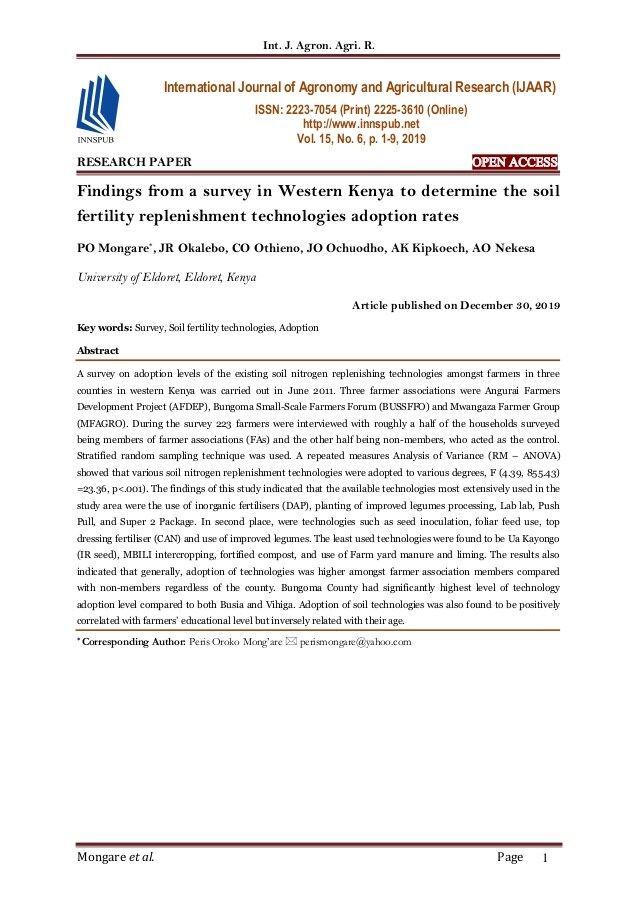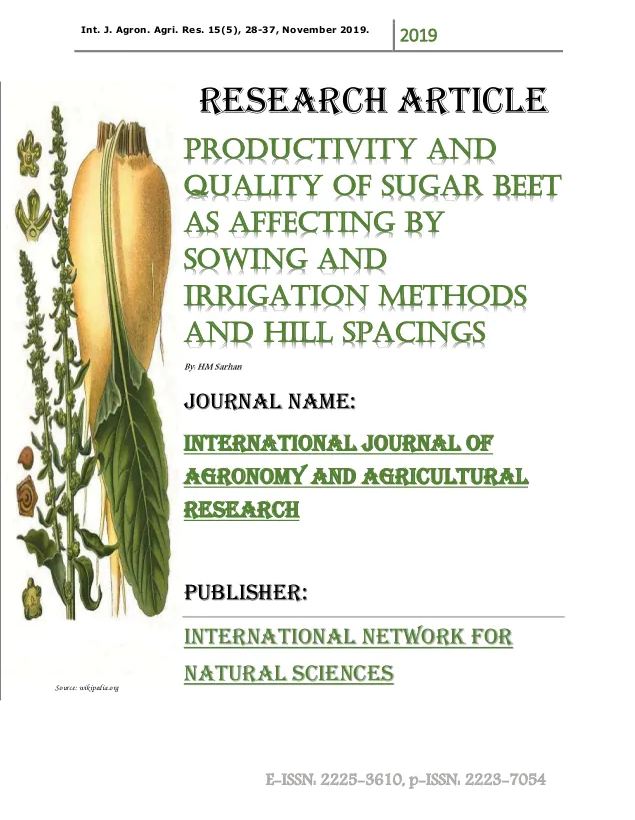An open access scholarly research journal called International Journal of Agronomy and Agricultural Research published an articles entitled "Findings from a survey in Western Kenya to determine the soil fertility replenishment technologies adoption rates." in December Issue 2019, under the volume of 15. This research work are developed by PO Mongare, JR Okalebo, CO Othieno, JO Ochuodho, AK Kipkoech and AO Nekesa from the University of Eldoret, Eldoret, Kenya. Get some knowledge about it.
Abstract
A survey on adoption levels of the existing soil nitrogen replenishing technologies amongst farmers in three counties in western Kenya was carried out in June 2011. Three farmer associations were Angurai Farmers Development Project (AFDEP), Bungoma Small-Scale Farmers Forum (BUSSFFO) and Mwangaza Farmer Group (MFAGRO). During the survey 223 farmers were interviewed with roughly a half of the households surveyed being members of farmer associations (FAs) and the other half being non-members, who acted as the control. Stratified random sampling technique was used. A repeated measures Analysis of Variance (RM – ANOVA) showed that various soil nitrogen replenishment technologies were adopted to various degrees, F (4.39, 855.43) =23.36, p<.001). The findings of this study indicated that the available technologies most extensively used in the study area were the use of inorganic fertilisers (DAP), planting of improved legumes processing, Lab lab, Push Pull, and Super 2 Package.
 |
| QR Code |
In second place, were technologies such as seed inoculation, foliar feed use, top dressing fertiliser (CAN) and use of improved legumes. The least used technologies were found to be Ua Kayongo (IR seed), MBILI intercropping, fortified compost, and use of Farm yard manure and liming. The results also indicated that generally, adoption of technologies was higher amongst farmer association members compared with non-members regardless of the county. Bungoma County had significantly highest level of technology adoption level compared to both Busia and Vihiga. Adoption of soil technologies was also found to be positively correlated with farmers’ educational level but inversely related with their age.
Discussion
Generally, adoption level of technologies was higher in members of farmer associations compared to non- members. This was in line with other studies, for instance, Odembo et al. (2010) and Kebeney et al. (2015), in which membership in groups accelerated the adoption of soil fertility technologies. Group membership speeds up technology adoption by enabling farmers to learn about a technology via other farmers and from other development agencies (Nkamleu, 2007). Ramisch et al. (2006) found that farmer groups are a popular source of knowledge as they foster solidarity and build in-group morale.
In addition, farmers rely on information gained through interaction with peers i.e. their own experience before they make important decisions. Members in associations have the added advantage of buying inputs collectively at cheaper prices and this enhances technology adoption. Thus, group membership to FAs has potential that could be utilized for technology and information dissemination to enhance adoption because of their wider scope of operation. In that perspective, an extension officer is able to reach more farmers in a group than individual farmers at a given period. The results indicated that overall, Bungoma County had significantly higher rates of technology adoption compared to both Busia and Vihiga counties. Different technologies address the needs of the soil differently in specific soils and productivity per unit area. Soil fertility technologies that lead to high yields have a higher rate of adoption (Sileshi et al., 2010).
Checkout more articles from Kenya
Checkout more articles from Kenya
This could have led to differences that occur in adoption of technologies counties. An example is Ua Kayongo that has higher adoption level in Busia and Vihiga because of higher infestation of striga due to low soil fertility than in Bungoma with higher soil fertility and lower striga infestation. In addition, membership of farmer associations was more extensive in Bungoma than in Vihiga or Teso. Given the beneficial effect of membership to farmer association with respect to adoption of soil management technologies, this could indirectly explain the higher adoption rates in Bungoma. Overall, the respondent’s gender did not significantly influence the adoption of the technologies. Odembo et al. (2010) have argued that gender per se might not heavily influence adoption of farm technologies. Rather, differences between men and women could arise from inherent resource inequities, in which women generally have lesser access to and control of critical resources, for instance, capital, land, labour, and information. For instance, this study found that the rate of adoption of top dressing technology (which involves the use of resource intensive nitrogenous fertiliser) is greater among males compared with females, suggesting that men might adopt resource intensive soil technologies more readily than female. Education highly influenced adoption of technologies, with more literate farmers comparatively using more technologies. This finding was similar to that by Kebeney et al. (2015) and Odembo et al. (2010). The positive effect of education on adoption of soil technologies might be two-fold: by increasing the knowledge and understanding of farmers about the techniques and secondly, better educated farmers are likely to have more disposable incomes, which could be crucial in financing some of the resource intensive technologies, such as, grain legume processing, liming, and DAP. The negative influence of age on adoption in the current study is consistent with the findings of Odera et al. (2000) in Kenya who found age to negatively influence adoption of soil fertility replenishment practices. As household heads grow older, their risk aversion increases and adapt less swiftly to new technologies. Increase in age also degrades the ability for the household head to participate in strenuous manual activities such as application of mineral fertilizers decline and this could reduce the speed of the adoption of labor-intensive technologies. Lastly, in this study, younger farmers belong to farmer associations, which have higher levels of technology adoption. Checkout more Int. J. Agron. Agri. Res. 15(6), 1-9, December 2019.






























